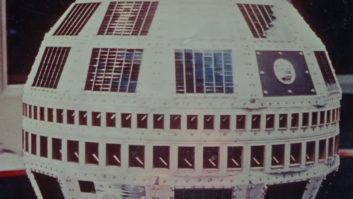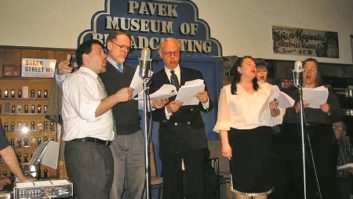Boy, do I wish I had thought of this idea: rock and roll plus space program-related features intermingled with cool-sounding sweepers and tag lines.

Of course, in my days as a young space geek (1965–75), this would have been unthinkable for “real” radio. Later, when I was covering NASA for CBS News Radio, such a format would have been perceived as too narrow for broadcast media.
But it’s a new era, and Third Rock Radio, billed wittily as “America’s Space Station,” is a promising new Internet enterprise.
Robert Jacobs, NASA’s deputy associate administrator of communications, says the music and features on their apps for iPhone and Droid are targeted toward listeners ages 18–30, a demographic he says NASA has had trouble reaching.
“Obviously, if we’re going to plug into a new generation of explorers, we have to get them exposed to what we’re doing, and this is an opportunity to do that,” he said. First, hook them in with the music; then, hook them with interesting information on the space program.
The station is promoted as “radio powered with NASA — a blend of art and science built to put you light years ahead with the best new music out there … really out there.” Since its debut in December, Third Rock Radio has gained some 7,000 fans on Facebook and 2,700 Twitter followers. By the end of April, the station had been sampled 1 million times at www.rfcmedia.com/thirdrockradio. It did its first live remote broadcast in April, from an event in Washington.
Texas Radio Hall of Famer Pat Fant is chief operating officer and co-founder of RFC Media in Houston (also home of NASA’s Johnson Space Center and Mission Control). RFC, a producer of online radio content, partners with NASA to create the show.
Brandcasting Is Smart Radio
RFC Media’s pitch to clients like NASA: Use smart radio to take the messaging battle to a new venue.
RFC manages production, programs music, schedules content elements, voices client-provided copy or produces client-supplied voice tracks from experts or celebrity hosts, according to its website. It handles music licensing and provides monthly audience reports; it provides streaming at a bit rate of 96 kbps.
“Your custom-produced, Internet-delivered, iPhone-enabled private network radio station streams live from your own website to greatly extend hang time with Web visitors,” the company states. “Your brand promise is then wrapped around something the hard-to-reach generation already cares a lot about: their music! It’s a fact that audiences now spend far more time streaming music online than hearing the car radio.”
As the company sees it, “The playing field has been leveled for custom, brand-specific music and information. … Accessing content based on personal preference is rapidly replacing what we’ve known in the past.” Or as Pat Fant says, “The delivery system for music and entertainment has permanently shifted and it’s never going back.”
Partnership
Who pays for Third Rock Radio? Jacobs says it doesn’t cost taxpayers a dime. The agreement with RFC Media is “a public/private partnership,” Fant says. “We are sponsored and supported, and were from day one.” Consumer Energy Alliance, Halliburton and the Washington Times are among the show’s current sponsors.
“We can provide (RFC) with NASA content and information and, in return, they’re the ones responsible for the programming,” Jacobs said.
For both RFC Media and NASA, the biggest goal is to get across to young people that science and engineering can be fun and exciting.
“We do have great interest in technology and certainly science and aerospace and astronomy,” Fant says. “There is a workforce crisis in this country. The next generation of our workforce just doesn’t have the skills of science and engineering.”
“For us, it’s a vehicle for us to deliver news and information to try to reach a different audience,” Jacobs said.
As for the technical side, Fant calls his set up “wholly unremarkable … a lot of computers with big sound cards and plenty of bandwidth … Our technical platform is fairly common and available to any (general manager). But the way we put it together is special.”
Fant says the music is in WAV format, with approximately 24 Dell computers and T-1 lines to send programming to Triton Digital, its streaming partner. With some 40,000 titles to choose from, production and editing is done on Cool Edit.
The hosts of Third Rock are called “Music Explorers,” presenting “discoveries in new music in a rock/alternative format that’s known to index among the highest in education and income,” Fant says. It also pulls in fans with a common interest who can share it through social media — a far more interactive experience to terrestrial’s traditional “static approach that pushes a less defined product tuned for a mass audience.”
NASA news and other space features and highlights are presented in an accessible, “street smart” (but not dumbed down) way.
As evidence of the success of the concept, Fant says, the average session length for online streaming is 51 minutes.
“In all my years of rock and roll broadcasting, if you could get someone to tune in for 51 minutes, you had reached the promised land.”
Peter King is an Orlando-based staff correspondent for CBS News Radio and a self-professed space geek who has covered NASA since 1994. This article is adapted from a story he reported for CBS.









